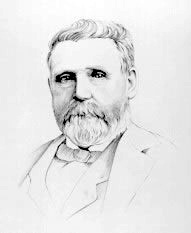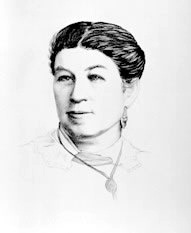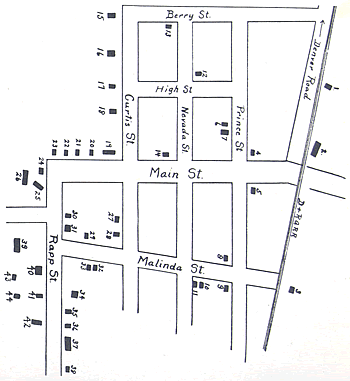Richard and Angeline Little


Richard and Angeline Little. Date unknown.
There is hardly a story about the history of Littleton that can be told without the mention of Richard Little's name. Not only did he lend his name to the town, but his vision, generosity and hard labors are too closely woven into the fabric of the community for any single string to be tugged at without moving the threads he lovingly stitched.
Richard Sullivan Little was born in Grafton, NH, on May 12, 1829. The grandson of a Revolutionary patriot, Richard was graduated from Norwich (VT) College at the age of 21 with a Bachelor's Degree in engineering and mathematics. He was also an accomplished violinist whose performing talents helped pay for his education. Four years later, in 1854, he married Angeline Harwood of Nashua, NH, and the newlyweds settled in Watertown, NH. The couple had one son, Lucius.
For the next decade Mr. Little was away from home for extended periods, working as a surveyor and engineer for a variety of railroads, each job taking him a bit further west on the continent. The last of these, in 1860, had him working in southern and central Wisconsin for a railroad whose payroll was intermittent, at best. By this time, he had moved Angeline and the household to Chicago to be closer to him.
Having saved a sum equal to maintaining the family for several months, Little resolved to find a steady paycheck and also to see Colorado Territory whose gold strikes were on the tongues of one and all. Gold digging was not his call, but the assurance that such an area would have need for engineers. He bid his wife farewell and traveled to Denver City in the heart of the Pike Peak rush. His hunch was correct, and he was soon busy surveying property lines and establishing a good reputation.
When the owners of the Capital Hydraulic Co. became concerned that their "city ditch" irrigation project was stalled, they hired R.S. Little in January, 1861 as its new engineer. Little immediately discerned the problem: the original engineer had miscalculated the gradient and the intake from the South Platte River would have to be moved several miles upstream from its location near present-day downtown Littleton. Work began at the new location, but the outbreak of the Civil War and financial difficulties caused a postponement in construction. Little went back to property surveying.

Map of downtown Littleton area, c.1883.
He also had grown very fond of the area of the misplaced ditch intake. Deciding that Colorado's dry climate would be therapeutic for Angeline's asthmatic condition, he homesteaded and purchased a total of 920 acres of what would eventually become the heart of Littleton. He knew that with some irrigation this land would be excellent for agriculture. Having built a substantial cabin, he traveled to Chicago in the spring of 1862 to bring his wife and worldly possessions to the territories on an ox-cart.
Using the abandoned portion of the city ditch to divert the Platte's water, he and his neighbors were soon successful at raising wheat, barley, corn and almost every crop they could imagine. The area's remoteness from Denver, however, made processing the grain or selling the surplus difficult. So in 1867, Little and several of his neighbors became partners in building a mill. They channeled the abandoned ditch back into the Platte and built their Rough and Ready Flour Mill along the race. It was an immediate success, and in so being guaranteed the life of the fledgling community. Despite two crippling early fires which caused the construction of a stone building for the mill in 1874, the Rough and Ready was the economic mainstay of the area for half a century.
On June 3, 1872, Little filed a plat of his land with the Territorial offices laying out the village of Littleton. The village was bounded by the Platte River to the west and the D&RG railroad tracks to the east, Berry St. to the north and Church St. to the south. Selling lots became a part of Little's livelihood. He also donated lots for churches, a schoolhouse and other civic improvements. In 1873, Little was elected to the Territorial legislature, where he championed the cause of expanded irrigation.
A newspaperman, visiting the growing "resort" and Denver suburb in 1889, wrote: "Mr. Little is very proud of the pretty suburban town he founded and gave a name to. [He] is a progressive old-timer and points with pride to the fact that his town has two churches, a number of good schoolhouses, six lanes of railway with fifty trains a day, suburban trains on the Denver & Rio Grande and the Denver & South Park, abundance of good water, plenty of beautiful trees and as charming a country town as can be found anywhere."
Richard Little lived out his days in the community he founded and loved, and remained its primary benefactor and most beloved citizen. He died, peacefully, at home on December 22, 1899, and his funeral procession, recalled Edwin Bemis, was "the largest that could ever be remembered."
Bibliography
Littleton Independent. Littleton Independent Publishers, 1888- .
Littleton Independent. The Story of Littleton, Denver's Best Suburb, Golden Jubilee Number, July 22, 1938. Littleton: Littleton Independent Publishers, 1938.
Littleton Museum. Photographic Archives.
____. Vertical File: Richard Little.
McQuarie, Robert J. and C.W. Buchholtz. Littleton, Colorado: Settlement to Centennial. Littleton: Littleton Historical Museum and Friends of the Library and Museum, 1990.
Photographs courtesy of the Littleton Museum unless otherwise noted. To order copies, contact the museum at 303-795-3950.
Compiled by Pat Massengill
Updated April 2021 by Phyllis Larison